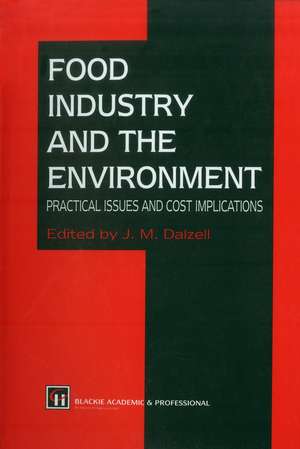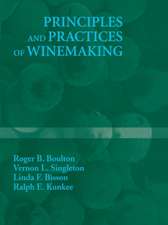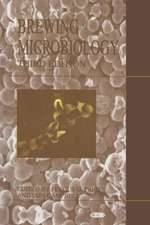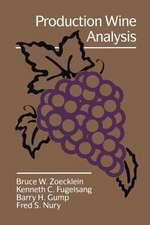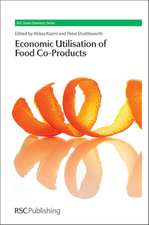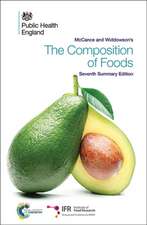Food Industry and the Environment: Practical Issues and Cost Implications
Autor J. M. Dalzallen Limba Engleză Paperback – 13 iul 2013
Preț: 395.63 lei
Nou
Puncte Express: 593
Preț estimativ în valută:
75.70€ • 79.05$ • 62.51£
75.70€ • 79.05$ • 62.51£
Carte tipărită la comandă
Livrare economică 15-29 aprilie
Preluare comenzi: 021 569.72.76
Specificații
ISBN-13: 9781461358725
ISBN-10: 1461358728
Pagini: 405
Ilustrații: XXI, 405 p.
Dimensiuni: 155 x 235 x 32 mm
Greutate: 0.59 kg
Ediția:1994
Editura: Springer Us
Colecția Springer
Locul publicării:New York, NY, United States
ISBN-10: 1461358728
Pagini: 405
Ilustrații: XXI, 405 p.
Dimensiuni: 155 x 235 x 32 mm
Greutate: 0.59 kg
Ediția:1994
Editura: Springer Us
Colecția Springer
Locul publicării:New York, NY, United States
Public țintă
ResearchCuprins
Editorial introduction.- J.M. DALZELL.- 1 Food from animals: environmental issues and implications.- 1.1 Introduction.- 1.2 Disposal of animal excreta.- 1.3 Energetic efficiency.- 1.4 Environmental influences upon perceptions of quality in food from animals.- 1.5 Conclusion.- 2 Organic and non-organic agriculture.- 2.1 Background.- 2.2 What is organic farming?.- 2.3 Organic husbandry techniques.- 2.4 The environmental impact of agriculture.- 2.5 Physical and financial performance of organic farms.- 2.6 Standards for organic food and farming.- 2.7 Future trends.- Further reading.- References.- 3 The environmental implications of genetic engineering in the food industry.- 3.1 Introduction.- 3.2 The regulatory climate.- 3.3 Consumer acceptability.- 3.4 A case study: the genetically engineered tomato.- 3.5 A case study: chymosin produced by genetic engineering.- 3.6 A case study: the genetic engineering of a food-grade organism.- 3.7 Conclusions and future prospects.- Acknowledgements.- References.- 4 Energy conservation and the cost benefits to the food industry.- 4.1 Introduction.- 4.2 Energy monitoring and targeting.- 4.3 Steam/hot water systems.- 4.4 Refrigeration.- 4.5 Combined heat and power.- 4.6 Further information.- 5 Noise and air pollution in the food industry: sources, control and cost implications.- 1 Noise pollution.- 5.1 Sources.- 5.2 Effects on health.- 5.3 Legislation.- 5.4 Methods of measurement.- 5.5 Methods of reduction.- 2 Air pollution.- 5.6 Air pollution sources and effects.- 5.7 Legislation affecting emissions into the air.- 5.8 Emissions, effects and controls.- 5.9 Monitoring of air pollutants.- 5.10 Odours: sources, nature and effects.- 5.11 Legislation relating to odour emissions.- 5.12 Control of odour emissions.- 5.13 Monitoring of odours.- 6 Water pollution in the food industry: sources, control and cost implications.- 6.1 Introduction.- 6.2 Controls.- 6.3 Costs.- 6.4 The characteristics and analysis of waste.- 6.5 Pre-treatments.- 6.6 Aerobic biological treatment.- 6.7 Anaerobic biological treatment.- 6.8 Sludge treatment.- 6.9 Conclusions.- References.- 7 Cooling and temperature controlled storage and distribution systems.- 7.1 Introduction.- 7.2 Refrigeration.- 7.3 Global warming and the ozone layer.- 7.4 Refrigerated transport systems.- 8 Packaging options.- 8.1 Introduction.- 8.2 Functions of packaging.- 8.3 Package selection.- 8.4 Wood.- 8.5 Paper and paperboard.- 8.6 Aluminium.- 8.7 Steel.- 8.8 Glass.- 8.9 Plastics.- 8.10 Effects of transportation.- 8.11 Packaging trends.- References.- 9 Disposal of used packaging.- 9.1 Introduction.- 9.2 Collection of used packaging.- 9.3 Identification of materials for collection and sorting.- 9.4 Landfill.- 9.5 Composting.- 9.6 Incineration.- 9.7 Reuse of packaging.- 9.8 Recycling.- 9.9 Multi-layer materials.- 9.10 Biodegradable plastics.- 9.11 The way ahead.- References.- 10 Management accounting for food industry environmental issues.- 10.1 Lessons from history: the rise and fall of management accounting and energy management.- 10.2 Classes of management information.- 10.3 Theory and empiricism in interpretation of measurements.- 10.4 Interpreting time series information: CUSUM.- 10.5 Variants in energy use pattern for buildings and processes.- 10.6 Relating energy use to efficiency.- 10.7 Budget management.- 10.8 The financial appraisal of energy saving and environmental protection measures.- 10.9 Environmental auditing.- 10.10 Conclusions.- References.
